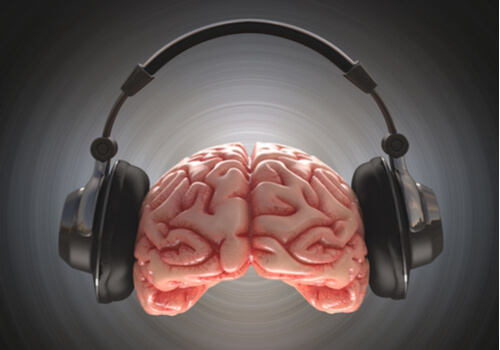The Health Benefits of Binaural Beats


Written and verified by the psychologist Valeria Sabater
Some define binaural beats as the new “technological drug“. The goal of this auditory phenomenon is to create a sensation of three-dimensionality in your brain. You can achieve this effect by generating two types of slightly different sound frequencies in each ear through headphones. Thus, you end up perceiving a third sound, one that, in turn, leads to a series of sensations.
These sensory stimulation feelings range from peace, well-being, and tickling. What this type of experience produces varies a lot from person to person. However, it does seem clear that people are seldom indifferent to it.
Binaural beats are all the rage, to the point that sound wave therapy emerged as an alternative approach to treating anxiety and stressful states.
No 100% conclusive studies support its results, meaning that binaural beats therapy is currently in the experimental phase. This doesn’t keep thousands of people from practicing it daily to relax, reduce insomnia, improve their concentration, or simply for pleasure.
An example, on the I-Doser website, created by a psychologist specialized in audio and music, defines binaural sounds as something addictive that produces enormous pleasure. Hence, they define it as the new digital drug. However, experts agree it can improve mood; although it’s due to mere suggestions in some cases.

Binaural beats, a phenomenon with a historical background
Binaural beats stem from the fact that the right and left ears receive a slightly different frequency tone, but the brain perceives them as a single more accelerated, and uniquely pleasurable, tone. For example, hearing a frequency of 120 Hertz (Hz) in one ear and 132 in the other would produce a 12 Hz binaural beat.
This may seem rather sophisticated but it isn’t new to the world of science. Heinrich Wilhelm Dove, a Prussian physicist, discovered it in 1839. He realized that something as simple as hearing constant tones reproduced at slightly different frequencies in each ear makes a person perceive a different overall sound. Dr. Dove defined this as “binaural beat”.
Since then, people have been experimenting with it in clinical settings. They’ve made attempts to improve a person’s quality of sleep while also reducing their anxiety. The results over several decades are highly variable, as this method works for some but others are indifferent to it.
Binaural beats to reduce anxiety and physical pain sensation
Some people use binaural beats with the idea of reducing their own anxiety. Other people who suffer pain due to injuries, joint problems, or even migraines also resort to this type of therapy.
Thus, a study conducted at the Department of Behavioral Sciences of the National Distance Education University, Dr. Miguel García found an average degree of effectiveness. This is because binaural beats were only effective in a limited number of patients. After two weeks of listening to binaural beats for 20 minutes, these only reduced 26% of the level of anxiety and pain perception of the sample.

Binaural beats therapy for insomnia
Research papers on binaural beats applied to patients with insomnia problems are more significant. Studies such as the one conducted at Iuliu Hațieganu University of Medicine and Pharmacy in Cluj-Napoca support its effectiveness in a very specific way, as it can help you fall asleep faster.
There are no conclusive data to this date regarding frequent awakenings or if the quality of sleep is more restorative and deep. Once again, there are emerging differences, as it helped some improve their quality of life by promoting night rest while others don’t show improvement.
Relaxation and mood improvement
Listening to binaural beats for 10 minutes every day, at a frequency of 6 Hz, can improve your mood. It does this by generating a sensation that’s similar to a meditation session in your brain. A person, therefore, feels more relaxed and receptive to their environment. Also, they get a sense of serenity and balance capable of enhancing motivation and positivity.
This outlines a series of improvements that may seem very interesting to you. However, we must emphasize what much of the research reveals: the results vary a lot. Therefore, researchers need to further investigate to understand what the actual changes it produces at the brain level are. This way, people can significantly benefit from this type of therapy.
The fact that the data isn’t conclusive doesn’t detract from its interest. Furthermore, one can test it to discover the specific sensations it causes in you. All you need is a good pair of headphones and then play any of the videos on YouTube on this subject. It’s always fun to immerse yourself in the fun sound universe!
Some define binaural beats as the new “technological drug“. The goal of this auditory phenomenon is to create a sensation of three-dimensionality in your brain. You can achieve this effect by generating two types of slightly different sound frequencies in each ear through headphones. Thus, you end up perceiving a third sound, one that, in turn, leads to a series of sensations.
These sensory stimulation feelings range from peace, well-being, and tickling. What this type of experience produces varies a lot from person to person. However, it does seem clear that people are seldom indifferent to it.
Binaural beats are all the rage, to the point that sound wave therapy emerged as an alternative approach to treating anxiety and stressful states.
No 100% conclusive studies support its results, meaning that binaural beats therapy is currently in the experimental phase. This doesn’t keep thousands of people from practicing it daily to relax, reduce insomnia, improve their concentration, or simply for pleasure.
An example, on the I-Doser website, created by a psychologist specialized in audio and music, defines binaural sounds as something addictive that produces enormous pleasure. Hence, they define it as the new digital drug. However, experts agree it can improve mood; although it’s due to mere suggestions in some cases.

Binaural beats, a phenomenon with a historical background
Binaural beats stem from the fact that the right and left ears receive a slightly different frequency tone, but the brain perceives them as a single more accelerated, and uniquely pleasurable, tone. For example, hearing a frequency of 120 Hertz (Hz) in one ear and 132 in the other would produce a 12 Hz binaural beat.
This may seem rather sophisticated but it isn’t new to the world of science. Heinrich Wilhelm Dove, a Prussian physicist, discovered it in 1839. He realized that something as simple as hearing constant tones reproduced at slightly different frequencies in each ear makes a person perceive a different overall sound. Dr. Dove defined this as “binaural beat”.
Since then, people have been experimenting with it in clinical settings. They’ve made attempts to improve a person’s quality of sleep while also reducing their anxiety. The results over several decades are highly variable, as this method works for some but others are indifferent to it.
Binaural beats to reduce anxiety and physical pain sensation
Some people use binaural beats with the idea of reducing their own anxiety. Other people who suffer pain due to injuries, joint problems, or even migraines also resort to this type of therapy.
Thus, a study conducted at the Department of Behavioral Sciences of the National Distance Education University, Dr. Miguel García found an average degree of effectiveness. This is because binaural beats were only effective in a limited number of patients. After two weeks of listening to binaural beats for 20 minutes, these only reduced 26% of the level of anxiety and pain perception of the sample.

Binaural beats therapy for insomnia
Research papers on binaural beats applied to patients with insomnia problems are more significant. Studies such as the one conducted at Iuliu Hațieganu University of Medicine and Pharmacy in Cluj-Napoca support its effectiveness in a very specific way, as it can help you fall asleep faster.
There are no conclusive data to this date regarding frequent awakenings or if the quality of sleep is more restorative and deep. Once again, there are emerging differences, as it helped some improve their quality of life by promoting night rest while others don’t show improvement.
Relaxation and mood improvement
Listening to binaural beats for 10 minutes every day, at a frequency of 6 Hz, can improve your mood. It does this by generating a sensation that’s similar to a meditation session in your brain. A person, therefore, feels more relaxed and receptive to their environment. Also, they get a sense of serenity and balance capable of enhancing motivation and positivity.
This outlines a series of improvements that may seem very interesting to you. However, we must emphasize what much of the research reveals: the results vary a lot. Therefore, researchers need to further investigate to understand what the actual changes it produces at the brain level are. This way, people can significantly benefit from this type of therapy.
The fact that the data isn’t conclusive doesn’t detract from its interest. Furthermore, one can test it to discover the specific sensations it causes in you. All you need is a good pair of headphones and then play any of the videos on YouTube on this subject. It’s always fun to immerse yourself in the fun sound universe!
All cited sources were thoroughly reviewed by our team to ensure their quality, reliability, currency, and validity. The bibliography of this article was considered reliable and of academic or scientific accuracy.
- Leila Chaieb, Elke Caroline Wilpert. Auditory Beat Stimulation and its Effects on Cognition and Mood States. Frontiers in Psychiatry. 2015; 6: 70. doi: 10.3389/fpsyt.2015.00070
This text is provided for informational purposes only and does not replace consultation with a professional. If in doubt, consult your specialist.







